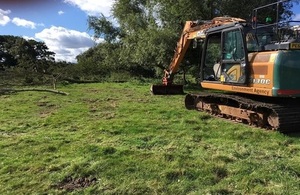Working with nature to reduce flood risk in Norfolk
Working with natural flood management to help manage flood risk to local properties and to improve habitats.

Natural flood management work begins
Work is under way on the first of five natural flood management schemes along rivers in Norfolk to help manage flood risk to local properties and improve habitats.
Natural flood management helps store flood water upstream and slows the flow of water along river channels, complementing the use of more traditional hard engineering downstream such as flood walls and embankments. Techniques such as tree-planting, restoring peatland, building leaky dams and reconnecting rivers to natural flood plains can all be used to reduce flood risk naturally.
The first two schemes under construction in Norfolk are on Camping Beck in the Bure Catchment at Buxton, and the River Yare at Marlingford.
The Buxton project is being carried out through a partnership between the Norfolk Rivers Internal Drainage Board, the Broadland Catchment Partnership and the Environment Agency. Works here involve storing flood flows upstream of Buxton village in an area that will enhance the environment through providing habitat, whilst helping to reduce flood risk downstream.
The Marlingford scheme is being carried out by a partnership involving Natural England, the Broadland Catchment Partnership and Environment Agency. A series of ‘flow deflectors’ and lengths of woody debris will be constructed in the channel of the River Yare to redirect flood water on to the flood plain, so it is stored upstream for longer and reduces the risk to communities downstream.
Sections of the riverbank will also be lowered at strategic locations for the same reason, and ‘scrapes’ will be dug in to the floodplain to increase water storage capacity. This will have the added benefit of providing habitat for wading birds such as lapwing, teal and snipe, plus invertebrates and other wildlife.
Similar techniques will be used at Ingworth on the River Bure, and Weybourne on the Spring Beck, with work due to begin soon.
A fifth scheme will be constructed at Worthing on the River Blackwater in partnership with the Norfolk Rivers Trust, with work taking place late Autumn.
The work is being carried out as part of a £15million Natural Flood Management programme, which was announced by Defra in 2017.
The Environment Agency’s Peta Denham, Area Flood Risk Manager for Essex, Norfolk and Suffolk, said:
I’ve always had an interest in how we can work more with nature to reduce flood risk, so I’m really pleased to get the opportunity to work on these natural flood management schemes in Norfolk.
We’ll help manage flood risk to communities at the same time as improving habitats – so it’s a win-win situation. I’m really looking forward to working with partners and our Regional Flood & Coastal Committee on these exciting projects on the ground, which will leave a real legacy of multiple benefits for future generations.
Environment minister Thérèse Coffey said:
The start of work on the new natural flood management (NFM) schemes is excellent news for Norfolk. The county is just one of the areas across England benefitting from our £15m investment in NFM and in the record £2.6billion we are investing overall to better protect against flooding.
Once finished, the Norfolk schemes will provide additional support in reducing the flood risks to local land, homes and businesses. On top of this, they will also enhance and restore some of the county’s wildlife habitats and improve water quality in its rivers.
This is a great example of how the Environment Agency is working with partners to protect Norfolk’s communities from the damage caused by flooding.
Emily Swan, Natural England lead adviser in farming and conservation, said:
The scheme at Marlingford is an exciting opportunity for us all to work together to create a resilient landscape along the Yare river valley.
Local communities and wildlife will benefit from a package of measures put together which are aimed at reducing flood risk, improving the water quality of the river and enhancing and preserving a mosaic of important habitats for fish, wintering birds and wildflower rich floodplain meadows in the valley.
Neil Punchard, Broadland Catchment Partnership officer, said:
This partnership helps co-ordinate farmers and organisations in working together. This can cost-effectively provide multiple benefits including wetland wildlife habitat, improved water quality, and reduced flood risk for local communities
Matthew Philpot, Project Engineer for Broads & Norfolk Rivers IDB said:
The joint working on natural flood management projects has delivered important, tangible benefits for many local communities across our county.
The integration of staff, resource and ideas has opened up a number of projects, which have given significant efficiencies along with multiple benefits to wildlife, people and property.
Working with nature and thinking in new, progressive ways about drainage opportunities has been highly beneficial and will continue to provide positive outcomes for many years to come.
Notes to Editors:
- Natural flood management is an important part of the Environment Agency’s strategy in protecting communities from flood and coastal erosion risk.
- It can be a cost-effective and sustainable way to manage flood risk and coastal erosion alongside traditional engineering, while creating habitat for wildlife and helping regenerate rural and urban areas through tourism.
- Many flood and coastal schemes feature a mixture of hard and soft engineering and natural flood management.
For East Anglia press office please contact (24 hours): 0800 917 9250